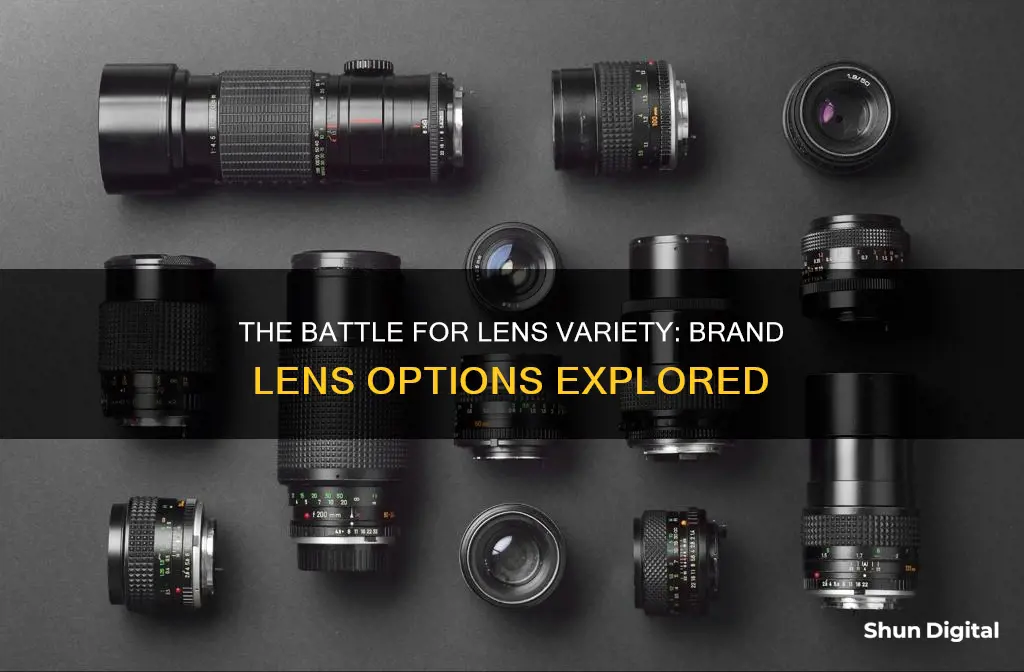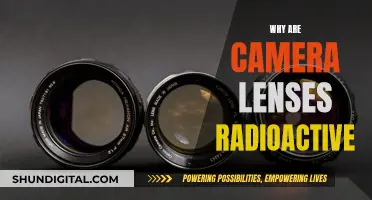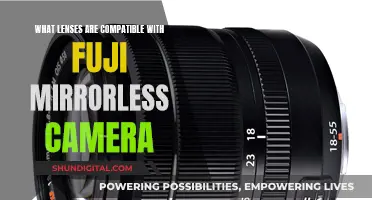
When it comes to camera lenses, there are two types of brands: original equipment manufacturers (OEMs) and third-party brands. Canon, Nikon, and Sony are the big three OEMs, with Canon offering the largest lens lineup available. However, in recent times, Sony has gained popularity and come close to being the most sold lens brand. Third-party brands, on the other hand, produce lenses for multiple lens mounts and camera brands. Some well-known third-party lens manufacturers include Sigma, Tamron, Tokina, and Rokinon. While the number of good lens brands can be confusing, it's important to consider factors such as compatibility, quality, and specific lens needs when choosing the right lens for your camera.
| Characteristics | Values |
|---|---|
| Best camera lens manufacturer | Canon |
| Number 2 lens manufacturer | Nikon |
| Number 3 lens manufacturer | Sony |
| Dark horse in the lens manufacturing industry | Fujifilm |
| Known for high-quality, durable yet compact lens line-up | Olympus |
| Robust full-frame mirrorless camera line-up | Panasonic |
| One of the oldest lens manufacturers | Leica |
| The oldest company on this list | Carl Zeiss AG |
| Largest independent producer of lenses in the world | Sigma |
| Main competitor to Sigma | Tamron |
| Oldest of the third-party lens manufacturers | Tokina |
| High-quality prime lenses | Samyang/Rokinon |
What You'll Learn
- Canon, Nikon, and Sony are the top three camera lens manufacturers
- Canon has the largest lens lineup available
- Nikon is known for its stellar quality lenses
- Sony acquired Konica Minolta in the early 2000s and has been on an absolute tear ever since
- Fujifilm, Olympus, and Panasonic are up-and-coming brands doing interesting things with mirrorless cameras

Canon, Nikon, and Sony are the top three camera lens manufacturers
Canon sells the most cameras out of all the major photography brands. This has been the case since the days of the DSLR camera. But the popularity of Canon has carried over to the mirrorless era as well. Canon has always catered to photographers at all levels. They make incredible machines for professionals, but their entry-level models are also excellent. That was true with DSLRs and it’s still true with mirrorless cameras. Canon has now turned their attention to the RF range of mirrorless cameras, which is their main focus.
Nikon is in second place in terms of camera sales, but still some way off Canon. That’s not to say Nikon is the inferior brand, and they still sell a huge amount of cameras. But they offer a similar range of cameras to Canon without breaking much new ground. Nikon cameras are well worth buying, however. They cover everything, including entry-level models, vlogging cameras, intermediate cameras, and high-performance machines for pros. Nikon has halted all DSLR development and now focuses solely on mirrorless cameras.
Sony sells fewer cameras than Nikon and Canon, and they offer fewer camera models. But most of their cameras sit at the professional end of the market. Sony is the master of the full-frame mirrorless camera, and Sony cameras have been setting new standards for the last decade or more. Sony has had the longest time to develop their mirrorless system, and so in some ways, they are the most advanced. They also opened their lens mount protocol so that third parties can make lenses for the Sony E mount.
Canon, Nikon, and Sony all make superb lenses. Sony doesn’t have the same selection as Canon or Nikon, but they can definitely compete in terms of lens quality. Canon’s EF lens line for their DSLR cameras has one of the biggest selections of lenses in the photography world. They have prime and zoom lenses of all types, and you can find lenses for any type of photography. Nikon’s F-mount collection is even bigger than Canon’s EF collection. They have every possible photography situation covered. Sony can’t match Nikon or Canon for numbers, but they can compete when it comes to quality. They also have all bases covered, so there’s a Sony lens for any genre or style of photography.
Protect Your Gear: Packing Camera Lenses Efficiently and Safely
You may want to see also

Canon has the largest lens lineup available
Canon, Nikon, and Sony are the big three camera brands, but when it comes to the number of lenses available, Canon has the largest lens lineup on the market.
Canon offers a wide range of lenses, including EF lenses, which are compatible with both Canon full-frame and APS-C DSLRs, as well as EF-S lenses, which are designed specifically for Canon's APS-C cameras. The company also labels some of its EF lenses as "L" or "Luxury," indicating superior sharpness, autofocus, and build quality. These "L" lenses are particularly popular among sports and wildlife photographers, even as the industry shifts towards mirrorless cameras.
Recognising the shift towards mirrorless technology, Canon has expanded its RF-mount lens lineup, designed for its mirrorless bodies, and offers adapters to fit EF and EF-S lenses onto RF-mount cameras.
Canon's extensive lens ecosystem is one of the reasons why the brand remains popular among professional and hobbyist photographers, despite some criticism that the company has been slow to innovate in recent years.
While Nikon and Sony also offer impressive selections of lenses, Canon's range is broader and more versatile, earning it the title of the largest lens lineup available.
Renting Camera Lenses in San Diego: Where to Go?
You may want to see also

Nikon is known for its stellar quality lenses
Nikon is a Japanese optics and photography equipment manufacturer that is known for its stellar-quality lenses. The company is the world's second-largest manufacturer of cameras, camera lenses, binoculars, microscopes, and other equipment. Nikon's camera lenses, in particular, have gained a reputation for their exceptional performance and versatility.
The company's line of lenses, known as Nikkor, offers a wide range of options for various camera systems, including F-mount cameras, large format photography, and mirrorless cameras. Nikon's lenses are renowned for their sharp optics, vibrant colour reproduction, and durability. The company's commitment to innovation and technological advancements has resulted in lenses that deliver superior image quality, even in challenging lighting conditions.
One of the standout features of Nikon lenses is their ability to produce high-contrast negatives with very sharp resolution. This has been a hallmark of Nikon optics, dating back to the early days of photography. The Nikon Z-series, for example, features lenses with advanced optical designs, delivering exceptional image quality and bokeh. Additionally, Nikon's AF-S NIKKOR lenses are known for their fast and accurate autofocus, making them ideal for sports and wildlife photography.
Nikon also offers a diverse range of prime and zoom lenses, catering to various photographic needs. Their prime lenses, such as the NIKKOR Z 50mm f/1.8 S, are highly regarded for their low-light performance and creamy bokeh. On the other hand, their zoom lenses, like the AF-S NIKKOR 70-200mm f/2.8E FL ED VR, provide versatility and flexibility for photographers who need to quickly adapt to changing scenes.
Furthermore, Nikon's lenses are built to last, with durable construction that can withstand the demands of professional use. The company's gold ring series, for instance, features lenses with metal barrels and mounts, ensuring a long lifespan. Nikon's attention to detail and commitment to quality have earned the trust of photographers worldwide, solidifying their reputation as a leading lens manufacturer.
In addition to their optical excellence, Nikon lenses are also known for their ergonomic designs, making them comfortable to use during extended photo shoots. The placement of focus rings and switches is well-thought-out, ensuring easy access and smooth operation. This level of craftsmanship and attention to detail sets Nikon lenses apart, contributing to their stellar reputation in the photography world.
Understanding Crescent Glare in Camera Lenses
You may want to see also

Sony acquired Konica Minolta in the early 2000s and has been on an absolute tear ever since
Sony's acquisition of Konica Minolta in the mid-2000s marked a turning point for the company, propelling it into the serious photography market and setting it on a path of rapid innovation and expansion.
Konica Minolta was formed in 2003 through the merger of two Japanese imaging powerhouses, Konica and Minolta. However, the new company struggled to adapt to the digital revolution sweeping the industry, and by 2006, it was clear that its future lay elsewhere. This presented an opportunity for Sony, which was already a well-established conglomerate with a foothold in the digital camera market through its Cybershot line of compact cameras.
The acquisition of Konica Minolta's camera business gave Sony access to valuable intellectual property and expertise in the field of photography. It also allowed Sony to leverage the brand equity and loyalty associated with the Minolta name, particularly among serious photographers. Sony's first DSLR, the Alpha A100, built upon the foundation laid by Konica Minolta, incorporating features such as in-body image stabilization and eye-start autofocus.
Building on this strong start, Sony rapidly expanded its DSLR offerings, introducing new models such as the higher-end A700 and diversifying its product line with the simultaneous release of the A200, A300, and A350. In 2008, Sony made a bold move with the release of the A900, which boasted the highest resolution full-frame DSLR sensor available at the time. By the end of that year, Sony had become the fastest-growing brand in the DSLR market, capturing the third-largest share in just two years.
Sony's success can be attributed to its willingness to innovate and embrace new technologies. While other companies were slow to adapt to the changing landscape, Sony stepped out of its comfort zone, venturing into new areas such as mirrorless interchangeable lens cameras with the Alpha NEX-3 and NEX-5, and the first-ever Pellicle Mirror DSLR, the SLT A55. This spirit of innovation has characterised Sony's approach to product development, leading to a string of industry firsts and a reputation for forward-thinking design.
Today, Sony continues to build on its strong foundation, solidifying its position as a leader in the photography market and pushing the boundaries of what cameras can do.
Understanding Camera Lens Interchangeability: What You Need to Know
You may want to see also

Fujifilm, Olympus, and Panasonic are up-and-coming brands doing interesting things with mirrorless cameras
While Canon and Nikon have long been the go-to brands for serious photographers, the market has seen a shift in recent years, with other brands such as Fujifilm, Olympus, and Panasonic gaining popularity. These three brands are known for their innovations in mirrorless camera technology.
Fujifilm's X Series mirrorless cameras, for instance, are known for their compact size and outstanding image quality. The brand has developed the X-Trans CMOS sensor, which produces high-quality images with rich colours, tonality, and dimensionality. Fujifilm's mirrorless cameras also feature a diverse lineup, catering to both professional and amateur photographers. Additionally, their cameras are lighter and more compact than traditional DSLRs, making them ideal for travel photographers.
Similarly, Olympus and Panasonic have also made strides in the mirrorless camera market. Their cameras feature smaller sensors, which result in cheaper lenses and more portable devices. While this does limit their low-light performance, Olympus and Panasonic cameras remain excellent options for travel and portability.
The rise of these three brands in the mirrorless camera market demonstrates a shift in the photography industry. With their innovative features and compact designs, Fujifilm, Olympus, and Panasonic are attracting photographers seeking alternatives to the traditional DSLR options offered by Canon and Nikon.
Cleaning Your Camera Lens: Tips for Sparkling Glass
You may want to see also
Frequently asked questions
Canon has the largest lens lineup available.
Nikon, Sony, Fujifilm, Olympus, and Panasonic are also well-known for their quality lenses.
Canon, Nikon, Sony, Sigma, and Zeiss are all renowned for their quality lenses.







